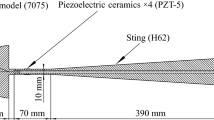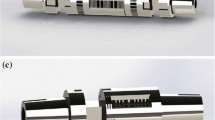Abstract
A stress wave internal force balance for the High Enthalpy Shock Tunnel Göttingen (HEG) of the German Aerospace Center (DLR) to measure lift, pitching moment and drag was designed, calibrated and tested. The balance is designed to measure forces in ground based test facilities with test times in the order of milliseconds on models additionally instrumented with surface pressure and wall heat flux gauges from angles of attack of −40° to 20°. Experiments in HEG were performed on a 303 mm long, 10° half angle blunt cone at angles of attack from −20° to 0°. The tests were conducted utilizing two different operating conditions at total specific enthalpies of 3.0 and 3.5 MJ/kg and dynamic pressures of 30 and 72 kPa. The performance of the balance was assessed by comparing the measured force and moment coefficients with computational fluid dynamics (CFD) predictions.






















Similar content being viewed by others
Notes
Although this loading excluded skin friction, the magnitudes are comparable to the viscous CFD determined loads given in Table 2.
If any surface loses contact during the test time, non-linearities may enter the system.
Note that time zero corresponds to flow arrival at the Pitot probe in all subsequent plots.
For condition XI, the Reynolds number based on chord length was approximately 1.1 × 106, while for condition XII it was approximately 0.5 × 106. The Spalart Allmaras model with Edward’s modification was used to model the turbulent boundary layer flow.
The “corrected” axial force is obtained through the multiplication of surface area and the measured back pressure plus the deconvolved thrust force.
References
Griffith, B.J., Maus, J.R., Majors, B.M.: Addressing the hypersonic simulation problem. J. Spacec. Rocket. 24(5), 334–341 (1987)
Paull, A., Alesi, H., Anderson, S.: The HyShot flight program and how it was developed. In: 11th AIAA / AAAF Space Planes and Hypersonic Systems and Technologies Conference. Orleans, France (2002)
Longo, J.M.: Present results and future challenges of the DLR SHEFEX program. AIAA 2009–7226. In: 16th AIAA/DLR/DGLR International Space Planes and Hypersonic Systems and Technologies Conference. Bremen, Germany (2009)
Hannemann, K., Martinez Schramm, J.: Short-duration testing of high enthalpy, high pressure, hypersonic flows. In: Tropea C., Yarin A.L., Foss F. (eds.) Springer Handbook of Experimental Fluid Mechanics. Springer, Heidelberg (2007)
Bernstein, L.: Force measurement in short-duration hypersonic facilities. AGARDograph 214 (1975)
Jessen, C., Grönig, H.: A six component balance for short duration hypersonic facilities. In: New Trends in Instrumentation for Hypersonic Research, pp. 295–305. ONERA, Le Fauga-Mauzac, France (1992)
Störkmann, V., Olivier, H., Grönig, H.: Force measurements in hypersonic impulse facilities. AIAA J. 36(3), 342–348 (1998)
Itoh, K., Ueda, S., Tanno, H., Komuro, T., Sato, K.: Hypersonic aerothermodynamic and scramjet research using high enthalpy shock tunnel. Shock Waves 12(2), 93–98 (2002)
Intrieri, P.F., Donn, B.K., Chapman, G.T., Terry, J.E.: Ballistic range tests of ablating and non-ablating slender cones. AIAA J. 8(4), 558–564 (1970)
Naumann, K.W., Ende, H., Mathieu, G., George, A.: Millisecond aerodynamic force measurement with side jet model in the ISL shock tunnel. AIAA J. 31(6), 1068–1074 (1993)
Tanno, H., Kodera, M., Sato, K., Takahashi, M., Itoh, K.: Aerodynamic force measurement on a large-scale model in a short duration test facility. Review of scientific insturments 76 (2005)
Sahoo, N., Suryavamshi, K., Reddy, K.P.J., Mee, D.J.: Dynamic force balances for short-duration hypersonic testing facilities. Exp. Fluids 38, 606–614 (2005)
Laurence, S.J., Deiterding, R., Hornung, H.G.: Proximal bodies in hypersonic flow. J. Fluid Mech. 590, 209–237 (2007)
Tanno, H., Komuro, T., Sato, K., Itoh, K.: Aerodynamic force measurement technique with accelerometers in the impulsive facility HIEST. In: Hannemann, K. and Seiler, F. (eds.) Shock Waves—26th International Symposium on Shock Waves, Springer (2009)
Laurence, S.J., Hornung, H.G.: Image-based force measurement in hypersonic facilities. Exp. Fluids 46, 343–353 (2009)
Laurence, S.J., Karl, S.: An improved visualization-based force-measurement technique for short-duration hypersonic facilities. Exp. Fluids 48, 949–965 (2010)
Sanderson, S.R., Simmons, J.M.: Drag balance for hypervelocity impulse facilities. AIAA J. 29(12), 2185–2191 (1991)
Mee, D.J., Daniel, W.J.T., Simmons, J.M.: Three-component force balance for flows of millisecond duration. AIAA J. 34(3), 590–595 (1996)
Smith, A.L., Mee, D.J., Daniel, W.J.T., Shimoda, T.: Design of a force balance for shock tunnel measurement of aerodynamic forces on HYFLEX. In: Proceedings 21st International Symposium on Shock Waves, pp. 569–574 (1997)
Robinson, M.J., Mee, D.J., Tsai, C.Y., Bakos, R.J.: Measurement of three components of force on a large scramjet in a shock tunnel. J. Spacecr. Rocket. 41(3), 416–425 (2004)
Robinson, M.R.: Simultaneous lift, moment and thrust measurements on a scramjet in hypervelocity flow. Ph.D. thesis, Department of Mechanical Engineering, The University of Queensland (2003)
Prost, R., Goutte, R.: Discrete constrained iterative deconvolution algorithms with optimized rate convergence. Signal Process. 7(3), 209–230 (1984)
Smith, A.L., Mee, D.J., Daniel, W.J.T., Shimoda, T.: Design, modelling and analysis of a six-component force balance for hypervelocity wind tunnel testing. Comput. Struct. 79(11), 1077–1088 (2001)
Thomson, W.T.: Theory of vibration with applications (4th edn.) Prentice Hall, New Jersey (1993)
Hannemann, K.: High enthalpy flows in the HEG shock tunnel: Experiment and numerical rebuilding. AIAA 2003-0978. In: 41st AIAA Aerospace Sciences Meeting and Exhibit. Reno (2003)
Hannemann, K., Martinez Schramm, J., Karl, S.: Recent extensions to the High Enthalpy Shock Tunnel Göttingen (HEG). In: Proceedings of the 2nd International ARA Days “Ten Years after ARD”. Arcachon, France (2008)
McIntosh, M.K.: Computer program for the numerical calculations of frozen and equilibrium conditions in shock tunnels. Software CR-181721, The Australian National University (1968)
Gerhold, T., Friedrich, O., Evans, J., Galle, M.: Calculation of complex three-dimensional configurations employing the DLR-TAU-code. AIAA-paper 97-0167 (1997)
Reimann, B., Johnston, I., Hannemann, V.: The DLR TAU-code for high enthalpy flows. In: Notes on Numerical Fluid Mechanics and Multidisciplinary Design, vol. 87. Springer, Heidelberg (1997)
Acknowledgements
The authors would like to thank Ingo Schwendtke for operating the HEG facility. Sebastian Karl is also gratefully acknowledged for the CFD nozzle computations.
Author information
Authors and Affiliations
Corresponding author
Rights and permissions
About this article
Cite this article
Robinson, M.J., Martinez Schramm, J. & Hannemann, K. Design and implementation of an internal stress wave force balance in a shock tunnel. CEAS Space J 1, 45–57 (2011). https://doi.org/10.1007/s12567-010-0003-5
Received:
Revised:
Accepted:
Published:
Issue Date:
DOI: https://doi.org/10.1007/s12567-010-0003-5




